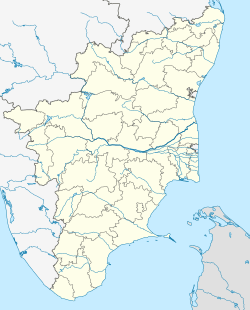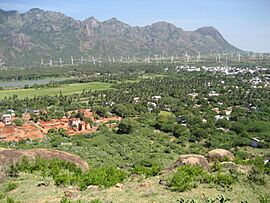Nagercoil facts for kids
Quick facts for kids
Nagercoil
|
|
|---|---|
|
Metropolis
|
|
|
Clockwise from top: Nagercoil Clock Tower, Nagaraja Temple, St. Xavier's Cathedral, Nagercoil Junction railway station
|
|
| Nicknames:
Granary of South Travancore, Greenest City of Tamilnadu, City of Temple Jewels, Southernmost City of India.
|
|
| Country | |
| State | |
| District | Kanyakumari |
| Named for | "Temple of the Nāgas" |
| Government | |
| • Type | Mayor-Council |
| • Body | Nagercoil Municipal Corporation |
| Area | |
| • Total | 61.36 km2 (23.69 sq mi) |
| Elevation | 82 m (269 ft) |
| Population
(It is an estimation due to 2021 census has been postponed due to Covid-19 pandemic)
|
|
| • Total | 522,759 |
| • Density | 8,813/km2 (22,830/sq mi) |
| Languages | |
| • Official | Tamil |
| Time zone | UTC+5:30 (IST) |
| PIN |
629001,629002,629003,629004
|
| Telephone code | 91-4652 & 91-4651 |
| Vehicle registration | TN-74 |
| Literacy | 96.99% |
| Climate | Aw (Köppen) |
| Precipitation | 2,477.7 millimetres (97.55 in) |
Nagercoil, also called Nagarkovil, is a city in the state of Tamil Nadu, India. Its name means "temple of snakes" (Nagas). It is the main city and administrative center of the Kanyakumari District.
Nagercoil is located near the southern tip of the Indian peninsula. It sits on hilly land between the Western Ghats mountains and the Arabian Sea. The city grew from an old trading town called Kottar, which is now part of Nagercoil.
Nagercoil was an important town in the old Travancore kingdom until 1956. In 1956, the Kanyakumari District, including Nagercoil, became part of Tamil Nadu.
The city is a busy center for many types of businesses in the Kanyakumari District. These include tourism, wind energy, and IT services. It also has marine fish production, rubber and cloves plantations, and farms that grow various crops and flowers. Factories here make fishnets and rubber products.
'Nagercoil Cloves' are famous for their special smell and health benefits. Cloves, pepper, and other spices are grown on farms in the nearby Western Ghats. Nagercoil is also close to important places like the ISRO Propulsion Complex and the Kudankulam Nuclear Power Plant.
The city and its district, Kanyakumari, are leaders in Tamil Nadu for things like education, income per person, and health. Nagercoil became a Municipal Corporation on February 14, 2019, celebrating its 100th year as a city.
Contents
Understanding the Name of Nagercoil
The name Nagercoil comes from the Tamil words Nagaraja koyil. This means "temple of Nagas," referring to snake deities.
Exploring Nagercoil's Past
The city of Nagercoil began to grow from an ancient trading center called Kottar. This area was known as 'Kottiara Metropolis' by ancient Greek writers like Ptolemy. They noted it was a busy place for trade.
Nagercoil was once called the Granary of Travancore because it produced a lot of food. It was also a key place for trading spices in the kingdom of Travancore starting from the 14th century. Merchants from Arab countries traded here even before Islam began. Many kings fought over this rich land, which had six rivers. Historians say its climate and rich plant life were unique in Tamil Nadu.
People and Population
According to a 2021 estimate, Nagercoil had about 522,759 people. There were slightly more females than males. About 20,241 children were under six years old. The city has a very high literacy rate of 96.99%. This means almost everyone can read and write.
Nagercoil's Economy
Nagercoil is one of 50 Indian cities listed in the World Startup Index. This means it's a good place for new businesses. Some major software companies like CapeStart Inc. and Hinduja Global Solutions have offices here. The city also has small factories that make parts for aerospace and satellites. These factories help the Indian Space Research Organisation (ISRO).
An important center for space startups, the Regional Academic Centre for Space by ISRO, is being built in Nagercoil. The city also exports 95 tons of fruits and vegetables to Gulf Countries. This brings in a lot of money. The flower market in Thovalai exports 350 tons of flowers to Kerala, Europe, and the Middle East.
Many small businesses, called cottage industries, thrive here. These include making fishnets, rubber products, and jewelry. Other small industries are making surgical gloves, Coir (from coconut fiber), and lace for export. Nagercoil has a high income per person, making it one of the richest small cities in India.
Energy Production in Nagercoil
Nagercoil has a large capacity for producing wind energy, about 1500 MW. This provides 20% of the state's renewable electricity. The Muppandal and Aralvaimozhi areas near Nagercoil are major centers for wind power.
Architecture and Buildings
The buildings in Nagercoil show a mix of styles. You can see very old Dravidian architecture and Kerala Architecture, as well as English Gothic Revival styles. Some structures date back to 3 A.D. The Roman writer Pliny the Elder mentioned Nagercoil as a trading city.
The Nagaraja Temple, Nagercoil is an example of old architecture. It has two main gods, Krishna and Nagaraja. Priests from Kerala serve here. Later, Dravidian and Kerala styles became more common, seen in the 16th-century Thanumalayan Temple.
St. Francis Xavier's Cathedral, Kottar was built in the 14th century. It shows a mix of Roman and local architecture. Saint Xavier helped protect the Venad kingdom from an attack. The king then gave him land to build a Catholic church. There was already a small church dedicated to Mary there since 1544 AD.
Many beautiful buildings show the influence of Kerala and British architecture. These include the Nagercoil Palace, Nagercoil Clock Tower, Home Church, Scott Christian College, and Scott Christian Higher Secondary School.
The Nagercoil Clock Tower is a famous landmark in the city center. It was built in 1893 to celebrate the visit of Sri Moolam Thirunal, the ruler of Travancore. The clock's pendulum was made in London. The clock was a gift to the Maharajah from Rev. James Duthie.
Education and Learning
Tamil is the main language spoken in Nagercoil. English and Malayalam are also widely used. Nagercoil has many old and respected schools and colleges. Some were founded over 150 years ago.
Famous colleges include Scott Christian College (started 1809), South Travancore Hindu College (started 1952), and Holy Cross College (started 1965). Well-known schools are Scott Christian Higher Secondary School (started 1819) and St. Joseph's Convent Higher Secondary School (started 1910).
The city also has many private schools that follow different education systems like CBSE and ICSE. There are government colleges for engineering and arts, and two government medical institutes. The literacy rate in Nagercoil is 96.99%, which is much higher than the average for India.
Culture and Traditions
In Vadasery, a part of Nagercoil, unique Temple jewelry is made. This jewelry is so special that it has a Geographical Indication (GI) tag from the Indian government. Classical dancers in India use these beautiful jewels.
Onam is a festival widely celebrated by Malayalam-speaking people. They draw colorful flower designs called 'athapoo' on the floor.
Navaratri is celebrated in a special way here. Idols of goddesses and gods travel from temples in Suchindrum, Padmanabhapuram Palace, and Kumarakovil to Thiruvananthapuram. Officials from the Government of Kerala give a grand welcome to the idols. After the ten-day festival, they return to their temples with big celebrations.
Getting Around Nagercoil
Bus Transport
Nagercoil has three main bus stands.
- Nagercoil Municipal Corporation Christopher Bus Stand (Vadasery): This is a large bus station with 52 bus bays. It connects Nagercoil to major cities across Tamil Nadu and Kerala. You can find reservation counters and shops here.
- Anna Bus Stand (Meenakshipuram, Nagercoil): This bus stand has 25 bus bays. It is mainly for local buses within the Kanyakumari district and to the Tirunelveli district.
- Vadasery Omni Bus Stand: Private buses for travel within the state and to other states operate from here.
Rail Transport
The city has two railway stations.
- Nagercoil Junction Railway Station (NCJ): This is the main railway station, also called Kottar Railway Station. It's one of the most important stations in Tamil Nadu. It has 6 platforms and 12 tracks. Trains from here go to many parts of Tamil Nadu and other major Indian cities like Mumbai, Delhi, and Bangalore.
- Nagercoil Town Railway Station (NJT): This station is on the Kanyakumari-Trivandrum line. Many important express trains and local trains stop here.
Sports and Activities
Nagercoil is home to one of the two Sports Authority of India Centers in Tamil Nadu. The other is in Chennai. There are plans to make Nagercoil a major sports hub in South India.
The Sports Development Authority of Tamil Nadu (SDAT) manages the Aringar Anna Outdoor Stadium in Vadasery and the SDAT indoor Stadium in Konam. Nagercoil also has an excellent swimming pool for athletes.
Various sports clubs in Nagercoil promote different activities. The Nagercoil Fencing Club, for example, supports fencing. There are also other clubs like The District Club and The Nagercoil Club.
See also
 In Spanish: Nagercoil para niños
In Spanish: Nagercoil para niños









